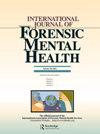How Do Persons Found NCRMD and Identified as Indigenous Differ from Other Persons Found NCRMD: Profiles, Trajectories, and Outcomes
IF 0.9
4区 医学
Q3 CRIMINOLOGY & PENOLOGY
International Journal of Forensic Mental Health
Pub Date : 2023-07-03
DOI:10.1080/14999013.2023.2205664
引用次数: 1
Abstract
Abstract Indigenous individuals are vastly over-represented among people incarcerated in Canada. We collected extensive clinical information and outcome data from Review Board (RB) files and obtained lifetime criminal records for 1800 individuals found Not Criminally Responsible on Account of Mental Disorder (NCRMD) in BC (n = 222), ON (n = 484), and QC (n = 1094). Indigenous and non-Indigenous people were compared on (a) socio-demographic, clinical, and criminal histories; (b) index offenses; (c) processing by the RB; and (d) recidivism. Compared to published rates of the disproportionate incarceration of Indigenous people in prisons in Canada (30%), just 3.9% of people in custody with an NCRMD finding were identified as Indigenous. Compared to non-Indigenous people, Indigenous people had higher rates of substance use disorders, personality disorders, and lower rates of mood disorders at verdict and came from low population density neighborhoods but high population density homes. Indigenous individuals were detained in custody longer and remained under supervision longer than non-Indigenous individuals but recidivated at similar rates. Criminal histories, mental health characteristics, and index offenses of Indigenous people found NCRMD were similar to non-Indigenous people found NCRMD. Further research is required to determine if seriously mentally ill Indigenous people who come into contact with the justice system are considered for the NCRMD defense similarly to non-Indigenous people and to explore why Indigenous individuals receive more restrictive dispositions, yet time to reoffending is similar.发现NCRMD并被认定为原住民的人与其他发现NCRMD的人有何不同:概况、轨迹和结果
摘要在加拿大被监禁的人中,土著人的比例远远过高。我们从审查委员会(RB)的文件中收集了大量的临床信息和结果数据,并获得了1800名不列颠哥伦比亚省因精神障碍(NCRMD)被认定为不负刑事责任的人的终身犯罪记录(n = 222)、ON(n = 484)和QC(n = 1094)。对土著人和非土著人进行了以下方面的比较:(a)社会人口、临床和犯罪史;(b) 指数犯罪;(c) RB的处理;以及(d)累犯。与公布的加拿大监狱中不成比例地监禁土著人的比率(30%)相比,根据NCRMD的调查结果,只有3.9%的在押人员被认定为土著人。与非土著人相比,土著人在判决时有更高的物质使用障碍、人格障碍和更低的情绪障碍发生率,他们来自人口密度低的社区,但居住在人口密度高的家庭。与非土著人相比,土著人被拘留的时间更长,在监督下的时间也更长,但再次犯罪的比率相似。NCRMD发现的土著人的犯罪史、心理健康特征和指数犯罪与非土著人的NCRMD相似。需要进一步研究,以确定与司法系统接触的患有严重精神病的土著人是否与非土著人一样被考虑为NCRMD辩护,并探讨为什么土著人受到更严格的处分,但再次犯罪的时间相似。
本文章由计算机程序翻译,如有差异,请以英文原文为准。
求助全文
约1分钟内获得全文
求助全文

 求助内容:
求助内容: 应助结果提醒方式:
应助结果提醒方式:


